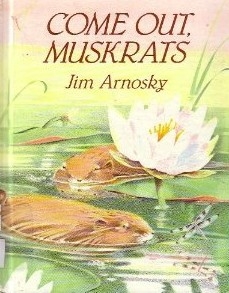- Home
- Tutorial
- Resource Guides
- Focus Areas
- LSF Programs
-
Professional
Development - Review Process
-
A project of LSF

Search for Resources
Description
This picture book with its simple text fosters an appreciation for nature and wetlands. The muskrats are urged to come out of their house and spend time in the marsh. They finally emerge to eat cattails, dry their fur and swim around, all while sharing their space with other wetland creatures such as the wood duck and damselfly. Quietness descends as the sun sets and nightime spreads over the marsh. But the muskrats who were so reluctant to come out during the day now "stay out" to swim and play until dawn returns.
Click here for more information regarding the author's books, school visits, or teaching resources.
General Assessment
Recommendation of how and where to use it
This story provides an excellent introduction to wetlands and would be a valuable precursor to a wetland field trip. The illustrations are accurate and students could learn identification skills by trying to recognize the different species in the book. Students could also learn more about the life history of muskrats and compare and contrast the similarities and differences between muskrats and beaver. The book could also be used as the basis for a project where students identify the importance of wetlands, and how they can be protected through simple actions such as not pouring pollutants down drains.
Relevant Curriculum Units
The following tool will allow you to explore the relevant curriculum matches for this resource. To start, select a province listed below.
- Step 1Select a province
- Alberta
- Step 2Select a grade level
- Kindergarten
- Step 3Select a subject
- Science
- Step 4Relevant matches
- Earth Systems: Understandings of the living world, Earth, and space are deepened by investigating natural systems and their interactions.
- Grade 1
- Step 3Select a subject
- Science
- Step 4Relevant matches
- Living Systems: Understandings of the living world, Earth, and space are deepened by investigating natural systems and their interactions.
- Grade 2
- Step 3Select a subject
- Science
- Step 4Relevant matches
- Living Systems: Understandings of the living world, Earth, and space are deepened by investigating natural systems and their interactions
- British Columbia
- Step 2Select a grade level
- Kindergarten
- Step 3Select a subject
- Science
- Step 4Relevant matches
- Science: Plants and animals have observable features
- Grade 1
- Step 3Select a subject
- Science
- Step 4Relevant matches
- Science 1: Living things have features and behaviours that help them survive in their environment
- Grade 2
- Step 3Select a subject
- Science
- Step 4Relevant matches
- Science 2: Living things have life cycles adapted to their environment
- Manitoba
- Step 2Select a grade level
- Kindergarten
- Step 3Select a subject
- Science
- Step 4Relevant matches
- Life Science
- Grade 1
- Step 3Select a subject
- Science
- Step 4Relevant matches
- Life Systems
- New Brunswick
- Step 2Select a grade level
- Kindergarten
- Step 3Select a subject
- Science
- Step 4Relevant matches
- Explore Your World: Well-Being
- Grade 1
- Step 3Select a subject
- Science
- Step 4Relevant matches
- Explore Your World: Well-Being
- Newfoundland & Labrador
- Step 2Select a grade level
- Kindergarten
- Step 3Select a subject
- Science
- Step 4Relevant matches
- Exploring Our World: Attitudes
- Grade 1
- Step 3Select a subject
- Science
- Step 4Relevant matches
- Needs and Characteristics of Living Things
- Northwest Territories
- Step 2Select a grade level
- Kindergarten
- Step 3Select a subject
- Science
- Step 4Relevant matches
- Science: Plants and animals have observable features
- Grade 1
- Step 3Select a subject
- Science
- Step 4Relevant matches
- Life Systems: Characteristics and Needs of Living Things
- Science 1: Plants and animals have features and behaviours that help them survive in their environment
- Grade 2
- Step 3Select a subject
- Science
- Step 4Relevant matches
- Science 2: Plants and animals have life cycles adapted to their environment
- Nova Scotia
- Step 2Select a grade level
- Kindergarten
- Step 3Select a subject
- Science
- Step 4Relevant matches
- Primary Science: Living Things
- Grade 1
- Step 3Select a subject
- Science
- Step 4Relevant matches
- Science 1: Needs of Living Things
- Nunavut
- Ontario
- Step 2Select a grade level
- Kindergarten
- Step 3Select a subject
- Science & Technology
- Step 4Relevant matches
- Problem Solving and Innovating: Overall Expectations
- Grade 1
- Step 3Select a subject
- Science & Technology
- Step 4Relevant matches
- Life Systems: Needs and Characteristics of Living Things
- Prince Edward Island
- Quebec
- Step 2Select a grade level
- Grade 1
- Step 3Select a subject
- Science & Technology
- Step 4Relevant matches
- Living things
- Grade 2
- Step 3Select a subject
- Science & Technology
- Step 4Relevant matches
- Living things
- Saskatchewan
- Step 2Select a grade level
- Kindergarten
- Step 3Select a subject
- Science
- Step 4Relevant matches
- Units & Outcomes
- Grade 1
- Step 3Select a subject
- Science
- Step 4Relevant matches
- Needs & Characteristics of Living Things
- Yukon Territory
- Step 2Select a grade level
- Kindergarten
- Step 3Select a subject
- Science
- Step 4Relevant matches
- Science: Plants and animals have observable features
- Grade 1
- Step 3Select a subject
- Science
- Step 4Relevant matches
- Science 1: Living things have features and behaviours that help them survive in their environment
- Grade 2
- Step 3Select a subject
- Science
- Step 4Relevant matches
- Science 2: Living things have life cycles adapted to their environment
Themes Addressed
Ecosystems (2)
- Appreciating the Natural World
- Biodiversity

